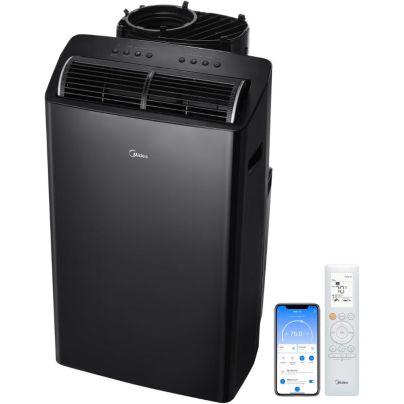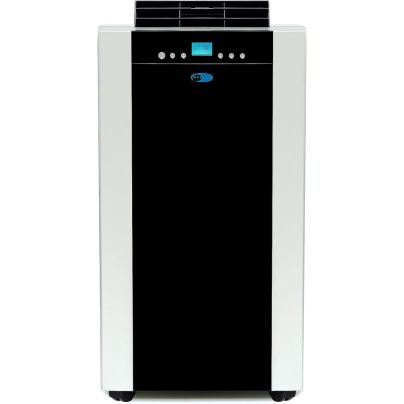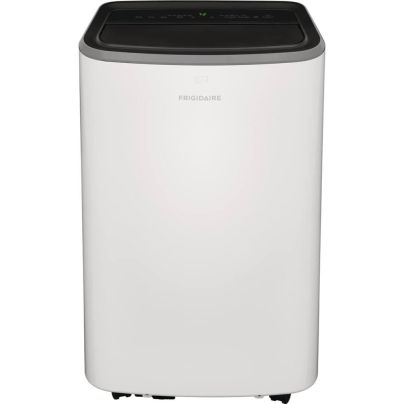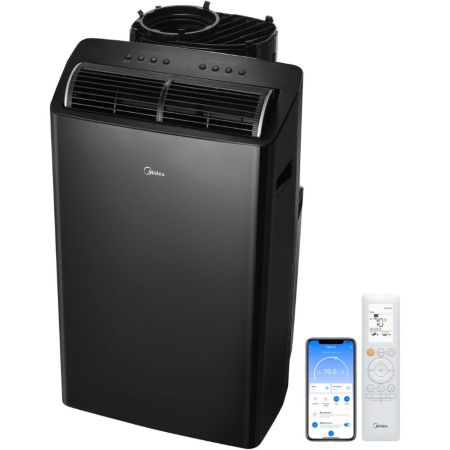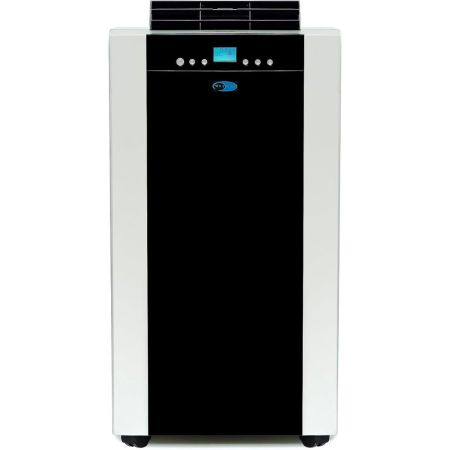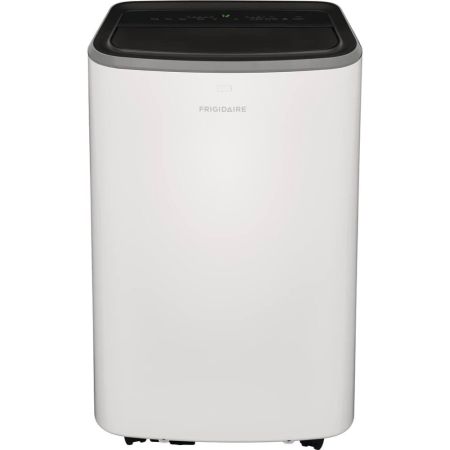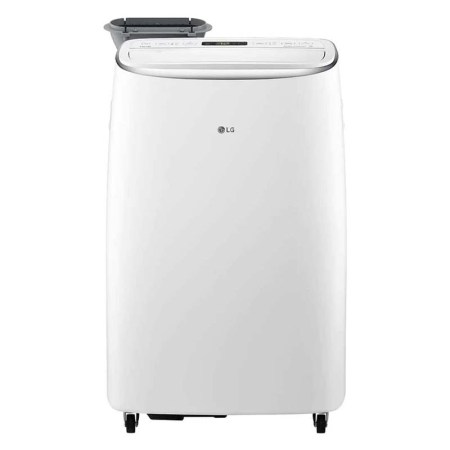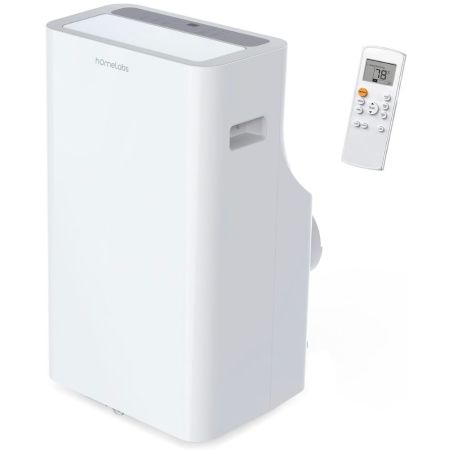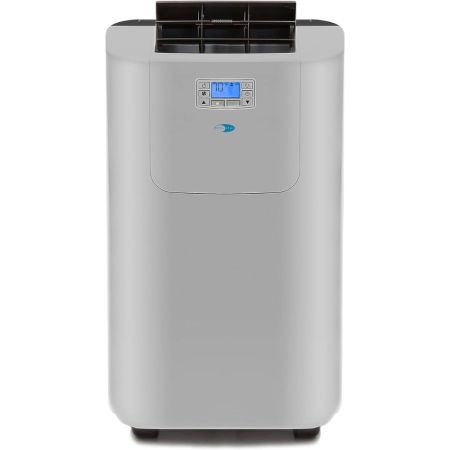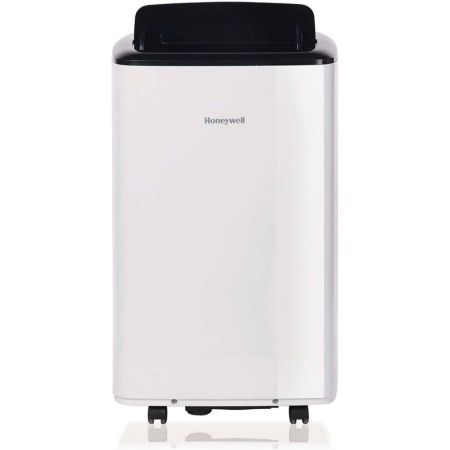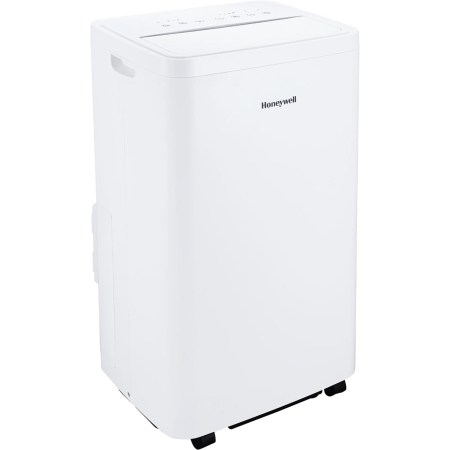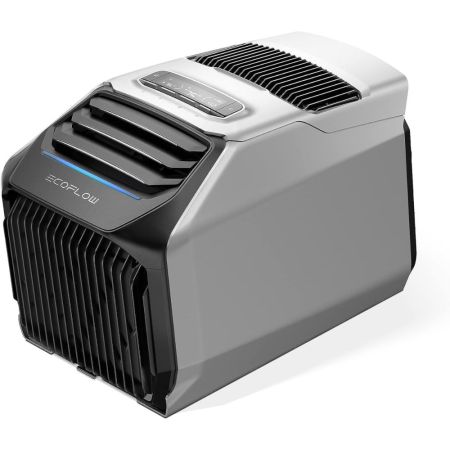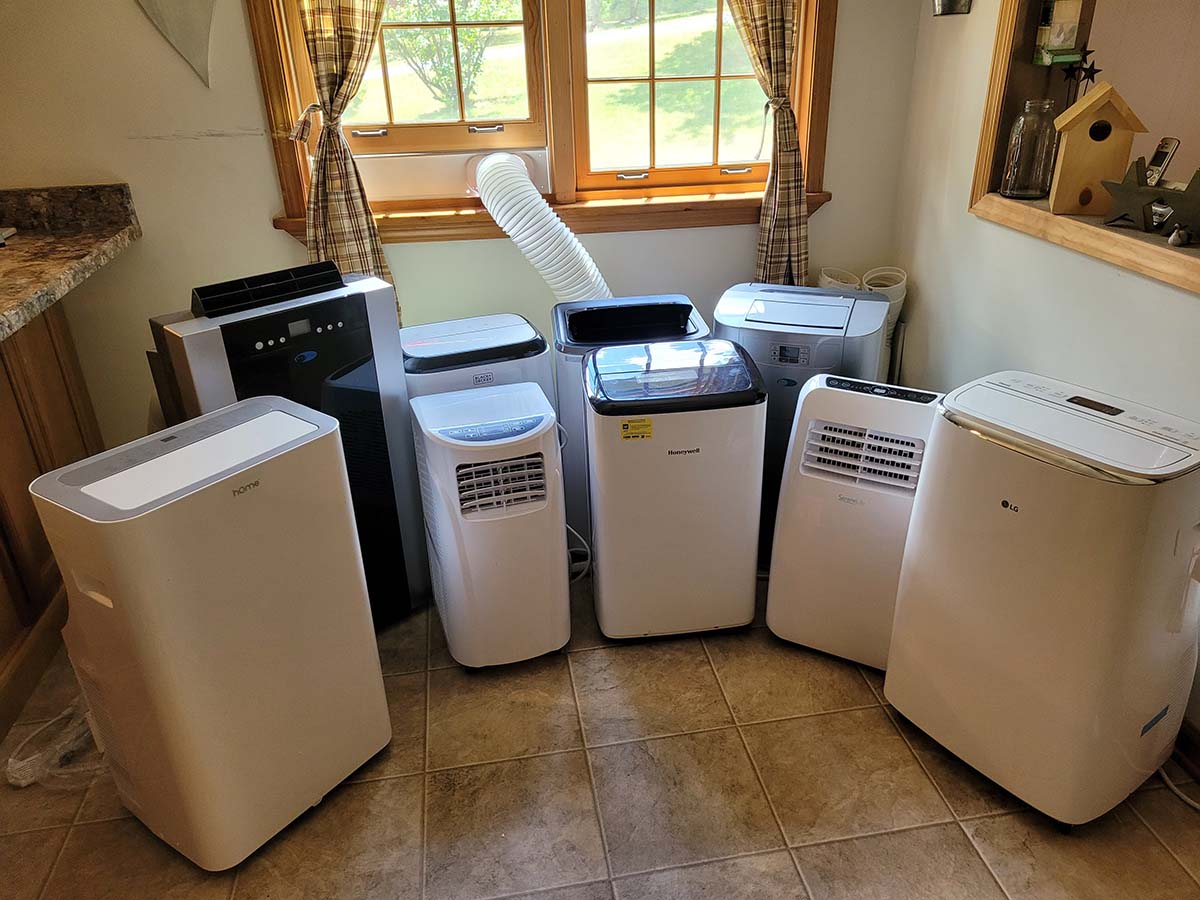
We may earn revenue from the products available on this page and participate in affiliate programs. Learn More ›
True to their name, portable air conditioning units are, well, portable—especially when compared to virtually all other types of equivalent cooling solutions. A portable AC unit sits entirely inside the home, transferring heat to the outdoors via an exhaust hose.
While they take up floor space and don’t run quite as efficiently as their in-window counterparts, they’re your best bet (or only bet) in many scenarios. We have researched and tested a variety of portable air conditioning units in 80+ degree Fahrenheit weather with humidity levels between 70 and 80 percent to see which units performed best and kept our area cool and comfortable.
We also reached out to Glenn Gault, the CEO at Gault Heating & Cooling, located in Northeast Ohio, to get his expert opinion. Continue reading for tips on how to choose the best portable AC unit for your space, and find out how the models we tested performed.
- BEST OVERALL: Midea Duo Portable Air Conditioner
- RUNNER-UP: Whynter ARC-14S Dual Hose Portable Air Conditioner
- BEST BANG FOR THE BUCK: Frigidaire Gallery Cool Connect Air Conditioner
- BEST SMART: LG Smart Dual Inverter Portable Air Conditioner
- BEST FOR LARGE ROOMS: hOmeLabs Portable Air Conditioner
- BEST FOR SMALL ROOMS: Whynter Elite ARC-122DS Portable Air Conditioner
- BEST QUIET: Honeywell Smart Wi-Fi Portable Air Conditioner
- BEST FOR HUMIDITY: Honeywell Smart Air Conditioner & Dehumidifier
- BEST FOR CAMPING: EcoFlow Wave 2 Portable Air Conditioner
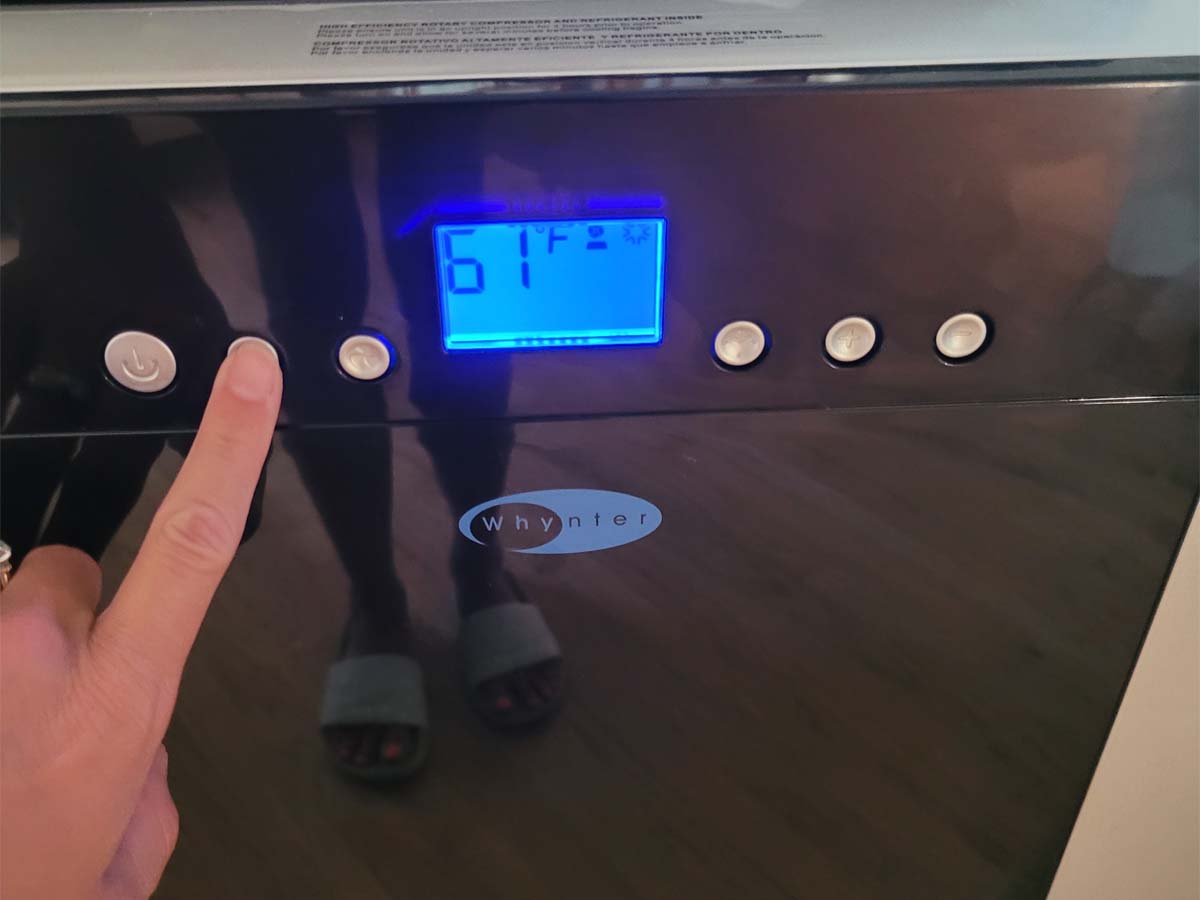
How We Tested the Best Portable Air Conditioners
After researching over 30 units, we chose the top portable air conditioners to test. Each unit was tested based on its British thermal units (BTUs) and recommended room size. (For a more detailed explanation of BTUs, read the Functions section after our product reviews.) For example, 10,000 BTUs and up were tested in a 550-square-foot living space. Units that offered less than 10,000 BTUs were tested in either a 250-square-foot room up to a 400-square-foot room.
When each room reached 80 degrees Fahrenheit, we turned on the unit and measured how long it took to cool the room to a comfortable 72 degrees Fahrenheit. We kept note of airflow, portability, and overall temperature of the air coming out of each unit. While testing, we also took note of the decibel level at each fan setting (high, medium, low). Once each particular room was cooled to 72 degrees Fahrenheit, we then left the unit on for 4 hours to test how efficiently each unit kept the room at that desired temperature.
After reviewing each unit and noting the above specifications, we then gave each unit an award it was best suited for based on our results.
| Testing Stats | |
| Products tested | 8 |
| Time spent testing | 16 hours |
| Tests performed | 2 to 3 |
| Price range | $300 to $1,300 |
Our Top Picks
The following list features some of the best portable AC units on the market today. See how each one fared in our tests, including the various functions offered and the overall cooling efficiency. We also included a thoroughly vetted list of pros and cons as well as the important specs for each product.
Best Overall
Midea Duo Portable Air Conditioner
Our Ratings: Ease of Use 5/5; Effectiveness 5/5; Portability 4/5; Noise 5/5; Value 5/5
Product Specs
- BTUs: 14,000 cooling; 12,000 heating
- Decibel level at lowest setting: 42
- Weight: 77.16 pounds
- Hose setup: Hose-in-hose
What We Like
- Provides powerful heating and cooling that circulates throughout the entire room
- Combined Energy Efficiency Ratio (CEER) rating of 10.8 is on the higher end for a portable AC/heater
- Voice-control feature is convenient and unique for this type of appliance
- Inverter technology delivers quiet and efficient operation for the eco-conscious user
What We Don’t Like
- Unit is heavy and requires a fair bit of effort to take upstairs
The Midea Duo 14,000 BTU portable air conditioner with heat is powerful enough to cool, warm, dehumidify, and circulate the air in rooms up to 550 square feet. It uses variable-speed inverter technology to increase energy savings by 40 percent in comparison to U.S. federal standards.
We found the Midea Duo to be the most powerful unit we’ve tested. We installed this unit on a hot and humid day to really test how quickly it could cool our area. Within minutes, we felt relief, and within a half hour, our living area was considerably cooler. We were incredibly impressed with this air conditioner’s ability to cool effectively and quickly.
You can operate the Midea Duo via the control panel or adjust the heat and cooling from afar thanks to the Midea app, Google Assistant, or Amazon Alexa. The efficient app was easy to set up and use. We also liked the option to use the remote control for easy operation.
While this portable AC and heater weighs a hefty 77.16 pounds, we found it easy to move thanks to its four-wheel design. It comes with an installation kit that includes a unique hose-in-hose design, which provides 20 percent better cooling two times as quickly as standard portable ACs. Maybe one of our favorite features was how easy this AC unit was to install. Sometimes, when installing portable air conditioners, you find yourself wrestling with the hoses and attachments. This unit’s built-in hoses eliminates that frustration.
Its air duct system also projects cool air further (up to 26 feet away), which we were able to feel comfortably sitting in the next room.
Although looks are certainly subjective, we really liked the sleek black appearance of this unit. It seemed to fit well with our decor without being a huge eyesore.
Get the Midea portable air conditioner at Amazon, Lowe’s or Walmart.
Runner-Up
Whynter ARC-14S Dual Hose Portable Air Conditioner
Our Ratings: Ease of Use 5/5; Effectiveness 5/5; Portability 2/5; Noise 4/5; Value 4/5
Product Specs
- BTUs: 14,000
- Decibel level at lowest setting: 56 or lower
- Weight: 83 pounds
- Hose setup: Dual-hose
What We Like
- Powerful cooling ability; provides instant cool air
- Remote control included for more convenient operation
- Dehumidifier mode available; great for humid spaces
- Rolling wheels makes this easy to transport from room to room when needed
What We Don’t Like
- Heavy at 83 pounds, which can make it difficult to move from floor to floor
Read our full review: Whynter ARC-14S Dual Hose Portable Air Conditioner
This Whynter dual-hose portable air conditioner features a maximum output of 14,000 BTUs and is suitable for rooms up to 500 square feet in size.
The portable AC unit can be set to cooling, fan-only, or dehumidifier mode. The fan speed in the cooling and fan mode can be adjusted between low, medium, and high to meet your personal preferences. The unit sits on four wheels, making it easy to move around and set up within the home.
This was among the most powerful portable AC units we tested. Setup took a few minutes as we connected each hose to the back of the unit and screwed the window panel in.
We turned the unit on when our 600-square-foot room reached 80 degrees Fahrenheit. The unit was set to the lowest cooling setting at 61 degrees Fahrenheit and the highest fan setting. Cold air was instantly pushed through the top vent, and the room was noticeably cooler within 10 minutes. Where traditional portable air conditioners are bulky, this model is sleek stainless steel and slimmer than most.
Get the Whynter ARC-14S portable air conditioner at Amazon, The Home Depot, or Best Buy.
Best Bang for the Buck
Frigidaire Gallery Cool Connect Air Conditioner
Our Ratings: Ease of Use 3/5; Effectiveness 4/5; Portability 4/5; Noise 4/5; Value 4/5
Product Specs
- BTUs: 13,000
- Decibel level at lowest setting: 52
- Weight: 69 pounds
- Hose setup: Single-hose
What We Like
- Quiet, making it ideal for bedrooms, offices, or other areas that require less disruption
- Remote control included for ease of operation from a distance
- Wheels provide portability from room to room
- Dehumidifying mode helps to pull moisture out of the air for a healthy living environment
What We Don’t Like
- Hose attachment can be sensitive, which can make installation difficult
This affordable AC unit boasts a maximum 13,000 BTU output and a remote for convenient control without getting up from the couch or bed. The air conditioner is suitable for rooms that are up to 550 square feet, making it a good choice for cooling an office or den. It also has a dehumidifier function to help reduce the ambient moisture in the air.
Setup of this unit was similar to the rest, with one hose connected to the back of the air conditioner and venting through a window mount. While this AC was able to cool a 500-square-foot room from 81 to 72 degrees Fahrenheit in about an hour, it was one of the quietest among the units we tested. After using the air conditioner for 2 weeks, we saw no difference in output, meaning it seems to be reliable and efficient. The remote control made it easy to change settings without the need to be near the unit.
While this unit performs well, we did find the hose attachment to be a bit flimsy; it would fall out of the back of the unit when moving it.
Get the Frigidaire portable air conditioner at Amazon, Lowe’s, The Home Depot, Wayfair, or AJ Madison.
Best Smart
LG Smart Dual Inverter Portable Air Conditioner
Our Ratings: Ease of Use 5/5; Effectiveness 4/5; Portability 3/5; Noise 4/5; Value 4/5
Product Specs
- BTUs: 10,000
- Decibel level at lowest setting: 44
- Weight: 55 lbs
- Hose Setup: Dual hose
What We Like
- Built-in dehumidifier as well as air conditioning system for excellent effectiveness
- Works with smartphones for easy adjustments as well as monitoring
- Easy to set up; can be fully put together in a matter of minutes
What We Don’t Like
- Heavyweight construction may be less portable than comparable top picks
The LG LP1419IVSM smart portable air conditioner features dual inverter technology, which allows for more efficient and quicker cooling. The unit allows users to customize their cooling preferences with three cooling and fan speeds along with a 24-hour timer. The LG ThinQ technology allows users to control the unit with a smartphone. The portable air conditioner can also act as a dehumidifier with a built-in dehumidifying mode, making it great for removing extra moisture in the air.
During testing, we found that this unit was among one of the quietest to run. During sleep mode, we measured about 42 to 45 dB, making it very comfortable to watch TV with it running. We tested this unit in our living space, which is about 600 square feet. It cooled the area efficiently and kept it cool and comfortable. When trying out the LG ThinQ app, we were able to easily pair the unit with two different smartphones with no issue. The LG ThinQ app allowed us to control the unit and set an operating schedule. The unit is also beautifully designed.
Our favorite part of using the LG portable air conditioner was the ease of setup. We had this unit installed within minutes. The air conditioner vent is built into the back of the unit so there is no fumbling with hose assembly. The hose and venting mount are among the best quality we’ve dealt with.
Get the LG portable air conditioner at The Home Depot or Best Buy.
Best for Large Rooms
hOmeLabs Portable Air Conditioner
Our Ratings: Ease of Use 3/5; Effectiveness 4/5; Portability 2/5; Noise 4/5; Value 3.5/5
Product Specs
- BTUs: 8,600
- Decibel level at lowest setting: 53
- Weight: 72 pounds
- Hose setup: Single-hose
What We Like
- Can cool rooms of up to 600 square feet; comes with multiple modes for user-friendliness
- Wheels for portability from room to room or to better direct airflow
- Remote control included for ease of operation anywhere in a room
- Quiet operation at no more than just 53 decibels; suitable for residential as well as commercial spaces
What We Don’t Like
- Heavier than other units, which can be difficult when you want to move the unit
- Vent is not adjustable, so airflow cannot be aimed in a specific direction
The hOmeLabs 8,600 BTU portable air conditioner can quickly cool down rooms of up to 600 square feet. Thanks to the unit’s convenient design, you can easily move this unit from room to room. The air conditioner has multiple modes available, including cool, fan, dry, sleep, and heat. This means the unit not only acts as an air conditioner but also as a dehumidifier and portable heater. With a built-in 24-hour adjustable timer, the air conditioner can be adjusted to your cooling needs.
During the testing of this unit, we really loved the sleek design, plus it was one of the easier units to wheel around from room to room despite its heavy weight of 72 pounds. The LED display was very intuitive and easy to use and read. When cooling an 80 degree Fahrenheit room, it brought the temperature down in our 600-square-foot living space in under an hour, making it one of the more powerful units on our list. The only downside is that the vent is on the top of this unit, which makes it hard to direct the airflow and is therefore not as easily adjustable as some other units.
Get the hOmeLabs portable air conditioner at Amazon, Walmart, or hOmeLabs.
Best for Small Rooms
Whynter Elite ARC-122DS Portable Air Conditioner
Our Ratings: Ease of Use 4/5; Effectiveness 5/5; Portability 4/5; Noise 3/5; Value 4/5
Product Specs
- BTUs: 12,000
- Decibel level at lowest setting: 52
- Weight: 68 pounds
- Hose setup: Dual-hose
What We Like
- Built-in dehumidifier helps to combat excess humidity in the air; suitable for areas with hot summer heat
- Compatible with Amazon Alexa for smart operation; provides voice commands
- Quiet operation volume makes it ideal for bedrooms and other living areas
What We Don’t Like
- Not Energy Star certification; not as eco-friendly and energy-efficient as comparable options
The Whynter ARC-122DS portable air conditioner’s sleek appearance helps it fit in with the design of most rooms. The sturdy wheeled base improves its portability, allowing it to be moved around on a flat surface easily, despite its 68-pound weight. It has a maximum output of 12,000 BTUs, ensuring that it can rapidly cool a room up to 400 square feet in size.
This unit was among some of the most powerful on the list and is ideal for a smaller bedroom, apartment, or office. Thanks to its dual-inverter technology, it cooled off our space quickly. We also liked how quiet it was when running at the highest setting, which was ideal for a bedroom.
When the humidity rose, the unit was able to keep up with the increased temperature and keep our living area more comfortable than some of the other units we tested. The stainless steel adds an elegant look as well.
Get the Whynter Elite portable air conditioner at Amazon or The Home Depot, Wayfair, Walmart or Best Buy.
Best Quiet
Honeywell Smart Wi-Fi Portable Air Conditioner
Our Ratings: Ease of Use 4/5; Effectiveness 4/5; Portability 4/5; Noise 3/5; Value 4/5
Product Specs
- BTUs: 10,000
- Decibel level at lowest setting: 52
- Weight: 63 lbs
- Hose setup: Single-hose
What We Like
- Not only cools the room but includes a built-in dehumidifier; suitable for regions with extremely hot summers
- Compatible with Amazon Alexa’s smart operation; allows for voice commands
- Quieter than many of the other models we tested, at only 52 decibels
What We Don’t Like
- Not Energy Star certified; not as energy-efficient as other options on the market
The Honeywell portable air conditioner is a powerful cooling unit. It is Wi-Fi enabled and is compatible with Amazon Alexa, making it easy to control with voice commands. The unit features a 24-hour timer along with the ability to set daily and weekly schedules. The built-in smart digital thermostat automatically turns on the AC unit based on preset conditions. This unit makes cooling your space easy and efficient.
We tested this unit in our 400-square-foot bedroom, and it handled our cooling needs efficiently. This unit is quiet enough for peaceful sleeping, and the timer came in handy when we wanted to avoid getting too cold during the night. The bedroom tends to get humid quickly, and this unit was able to cool even on humid days. With all of the remote options, we liked the fact that we did not have to get up to adjust the settings throughout the night or while relaxing. Installation is similar to most portable air conditioners with a single hose vented through the window. Honeywell’s hose seems of good quality, and installation only took about 5 minutes.
Get the Honeywell smart portable air conditioner at Amazon or The Home Depot.
Best for Humidity
Honeywell Smart Air Conditioner & Dehumidifier
Our Ratings: Ease of Use 4/5; Effectiveness 4/5; Portability 3/5; Noise 4/5; Value 4/5
Product Specs
- BTUs: 14,500
- Decibel level at lowest setting: 51
- Weight: 59.5 pounds
- Hose setup: Dual-hose
What We Like
- Dehumidifier can handle up to 101 pints per day, pulling much of the muggy humidity out of a room
- Dual dust filters feature helps keep the internal workings clean to extend the AC’s life
- Wheels and an easy-to-install window kit make this heavy machine portable if needed
- Uses an eco-friendly nonozone-depleting refrigerant
What We Don’t Like
- At just over 59 pounds, it is a bit heavier than some on this list, making it a challenge to carry up and down stairs
- Installation can leave some small gaps; consider adding additional foam or sealing with gaffer’s tape
The Honeywell 14,500 BTU compact portable AC with dehumidifier and fan is built to quickly cool rooms up to 700 square feet. What drew us to this unit is the fact that it uses an environmentally friendly refrigerant, making it a more sustainable option. It also uses an efficient dual-hose design and features an energy-saving timer.
This unit was installed in a 700-square-foot room. We really liked that we could easily control the unit via the remote control. It handled the humidity well and was able to cool the room from 78 degrees Fahrenheit to a comfortable 67 degrees Fahrenheit in a little over an hour.
Quiet at just 51 decibels, the Honeywell portable AC did not interrupt our sleep, and we really appreciated the built-in timer allowing us to set the unit to shut off after a few hours of cooling.
It uses dual dust filters (with washable filters) to keep its internal workings clean and extend its life.
Get the Honeywell dehumidifier portable air conditioner at Amazon, Wayfair, Walmart, or Best Buy.
Best for Camping
EcoFlow Wave 2 Portable Air Conditioner
Our Ratings: Ease of Use 3/5; Effectiveness 4/5; Portability 5/5; Noise 4/5; Value 4/5
Product Specs
- BTUs: 5,100 cooling; 6,100 heating
- Decibel level at lowest setting: 44
- Weight: 32 pounds
- Hose setup: Dual-hose
What We Like
- Cools or warms spaces by 18 degrees Fahrenheit in just 5 minutes
- Small and lightweight enough for easy travel and use in almost any environment
- 4 input options (AC, DC, solar, and portable power station) mean you can charge it virtually anywhere
- Provides up to 14 hours of runtime in Eco mode when paired with the EcoFlow Delta Max power station
What We Don’t Like
- Setting up the hoses can be inconvenient as they’re fairly cumbersome
- Requires regular draining in heating mode and when humidity is above 70 percent
- Battery runs down quickly when unit operates on high
Delivering 5,100 BTUs in cooling mode and 6,1000 when heating, the EcoFlow Wave 2 portable AC doesn’t need to be put away simply because the leaves are changing. Relatively lightweight at 32 pounds and measuring 20.4 inches long by 11.7 inches wide by 13.2 inches high, the battery-powered Wave 2 is a true go-anywhere appliance.
We tested the Wave 2 in various settings, including at a hot baseball game under a pop-up tent, camping in an enclosed tent, a small office, and a hot nonvented warehouse. In each setting, the Wave 2 provided rapid cooling for up to 8 hours.
You can charge the unique EcoFlow Wave 2 via four methods: solar, AC, car charger, or a compatible power station (sold separately). While we didn’t have any solar panels on hand, we did charge with the AC adapter, car charger, and power station, all of which charged the unit effectively. The Wave 2 also features a USB and USB-C port to charge external devices.
The settings on the Wave 2 are adjustable directly via the unit, or you can use the EcoFlow app with Wi-Fi or Bluetooth. It’s extremely quiet at just 44 decibels and did not disturb us during any of our testing locations.
One of the biggest advantages of this unit is that it does not need to be vented. While this is true, we found when using it indoors, it works best if it is vented. We tested it in a small office with no windows, and while it did cool the space directly in front of the air vent, it had a hard time keeping up with the output airflow, which was warm. This isn’t an issue when using the unit outdoors, and we found when using it at outdoor events or camping, it worked great for keeping us cooled off.
Get the EcoFlow portable air conditioner at Amazon, Walmart, REI, or EcoFlow.
Jump to Our Top Picks
What to Consider When Choosing a Portable Air Conditioner
Take some time to think about the various features and functions available in portable air conditioners before deciding on a specific product. You’ll want to consider factors like single- or dual-hose configurations, energy consumption, cooling capacity, room size, and even the noise produced by the portable AC before making a purchase.
Single vs. Dual Hose
- Single-hose AC units pull warm air from the space around it, cool the air, and dispose of heat and moisture through a hose that leads outside. These models are typically cheaper than their dual-hose counterparts but have one significant drawback: Since the unit relies on already-cooled air to bring down the temperature of the condenser, considerable energy goes to waste.
- Dual-hose AC units have both an intake and outtake hose. The intake hose draws in outdoor air to bring down the temperature of the condenser. The separate outtake hose disposes of the heat, humidity, and used air from the indoor space. While pricier, dual-hose units are more efficient and generally the wiser option, particularly for larger spaces.
Functions
Portable air-conditioning units have several different functions available depending on the product, including standard AC, evaporative air coolers, heaters, air purifiers, and humidifiers/dehumidifiers.
- Standard AC units function by pulling in stagnant air from the room and pumping it over cold coils to cool the air. Warm air and excess moisture are expelled to the outside through a hose. This function rapidly cools the air in the room.
- Evaporative air-cooler models typically use ice or cold water to cool the air in the room. The unit uses a fan to pull warm air in through a wet sponge or bucket of ice, then the same fan pushes the cool air out through the front of the portable air conditioner to cool the room. However, this function does not have the same level of cooling power as a standard portable AC.
- Heaters can sometimes be built into portable air conditioners, giving you the ability to switch between heating and cooling and enabling use throughout the warm and cold months of the year.
- Air purifiers are designed to pull in dust, dirt, hair, and other contaminants, trapping them in a filter and pushing out cleaner air. While some portable ACs include an air purifier function, this is a relatively rare and high-end feature.
- Humidifier/dehumidifier models increase or decrease the moisture in the air. Many portable AC units can act as dehumidifiers to pull in moisture and push out drier air, though it’s less common for a portable air conditioner to have a humidifier mode. Evaporative air-cooler ACs act as humidifiers while also cooling the air, so a specific humidifier setting isn’t as necessary.
Room Size
The size of the room matters when choosing a portable air conditioner, so be sure to select a unit with the appropriate output for cooling the space. Portable air-conditioner manufacturers will often provide the output of the device in BTUs, with each BTU equal to the amount of heat that the AC unit can remove from a room. The output of a portable air conditioner ranges from about 3,000 to 15,000 BTUs.
Typically, the cooling area of an evaporative air cooler is measured in cubic feet per minute (CFM). Calculate the necessary CFM for the target room by multiplying the length, width, and height of the room to find the volume, then dividing the total by 2: CFM = (L x W x H) divided by 2.
According to Glenn Gault, a heating and air conditioning expert, a common mistake consumers make is purchasing a portable air conditioner for the kitchen using the same criteria as they would for a bedroom or living room. “Cooking appliances generate significant heat, making it harder for the AC unit to cool the room,” he says. “Keep in mind that if you choose a portable AC unit for a kitchen, you need to increase the capacity by about 4,000 BTUs from what you would need for the room size.”
Energy Efficiency
Air conditioners with a BTU rating of 10,000 or higher are typically the most efficient at cooling a room, but the higher the BTU, the louder and heavier the model. Most AC units also come with an Energy efficiency Ratio (EER). A higher EER rating equates to greater efficiency; EER indicates the ratio of the air conditioner’s BTUs per hour to its power input, measured in watts.
In other words, cooling a larger space requires more BTUs, and some units are built with greater energy efficiency than others. The EER weighs output and input against each other to show how effective and efficient the unit will be. Many portable air conditioners have EER ratings between 8.5 and 10; any rating higher than 10 is ideal.
Portability
If the intent is to regularly move the AC unit around, consider investing in a smaller portable AC that’s easy to pick up.
Look out for portable air conditioners with handles on the side or back of the unit, which can make it easier to pick it up and adjust the positioning. Some portable ACs have wheels on the bottom of the unit as well. This is an especially helpful feature to move the air conditioner over a flat surface without needing to lift it off the ground.
Noise Level
In the past, air conditioners, fans, and heaters were known to produce very high noise levels due to the hum of the motor, fan blade rotation, and the force of the expelled air. Today, product advancements have significantly reduced the noise produced by these devices through intelligent engineering and enhanced insulation that dampens the sound.
The average AC unit now produces about 50 to 60 decibels (dB) of sound, while the quietest portable air conditioner options may only be 40 to 45 dB. For perspective, the sound of a person whispering is about 30 dB, a normal conversation is 55 to 65 dB, and ambient noises in a busy office or restaurant range from 70 to 80 dB.
Additional Features
Standard portable air conditioners are easy to use, allowing you to circulate cool air throughout the home. That said, some products come with extra features that can make them more convenient and user-friendly:
- Timers keep the portable air conditioner on for a set period of time. Once it reaches the end of this period, it will automatically shut off instead of running all day, which helps keep electricity costs low.
- Programmable settings on a portable air conditioner can include fan-speed settings, set temperatures, temperature ranges, sleep mode, and more. These settings are meant to provide complete control over the unit. A smart portable air conditioner can even integrate with smart-home systems like Amazon Alexa or Google Assistant to control the AC unit using voice commands.
- Night lights are a good option for those who walk around a fair amount at night, since the added illumination helps prevent injury (like accidentally kicking the air conditioner).
Installation and Maintenance
One of the main benefits of choosing a portable air conditioner is its typically easy installation. Standard portable AC units need an available power outlet and a place for the hose to filter out excess moisture and hot air. This is accomplished by running the hose through a custom frame that sits inside an open window, creating a seal around the window and around the hose to prevent leaks.
“You don’t need to hire a professional for portable air conditioner installation, and all you need to start it working is to fit an exhaust hose to a window for venting hot air outside,” says Gault.
Alternatively, evaporative air coolers don’t have a hose that has to run outside, but they do need cold water or ice in the sponge or bucket to cool the air that passes through the unit. Both styles require regular cleaning and may need to be drained if they have a dehumidifier function that collects water from the ambient air.
FAQs
These high-efficiency devices are a great option to keep your home cool in warm weather. For more info on how to shop for, use, and set up portable air conditioners, read on for answers to some of the most common questions.
A portable air conditioner is specifically made to be moved around an indoor space so that it can be set up wherever it’s needed most.
These devices do take up some floor space, but they are generally accepted in condos and apartments, as some landlords ban the use of a window air conditioner due to the risk of the unit falling out of the window.
Depending on the power output of the portable air conditioner, these devices can cool spaces from about 100 to 800 square feet. For example, the options on our list of top picks can cool rooms of 400 to 725 square feet and come with both air conditioners as well as dehumidifiers.
Portable air conditioners that have an evaporative air cooler function can be used in a room with no windows. The air is cooled when it passes through a cold wet sponge or a bucket of ice, and then it flows back out into the room without needing to be filtered outdoors.
The output of a portable air conditioner is typically given in BTUs, while electricity is measured in kilowatt hours (kWh). One kWh is equal to 1 kilowatt of power per hour. On average, a 7,000 BTU portable AC uses about 2.2 kWh; a 10,000 BTU unit uses about 2.9 kWh; and a 14,000 BTU AC unit uses about 4.1 kWh.
Meet the Tester
As the executive editor of Commerce/Product Reviews, Stephanie Cronk has spent years researching and testing products. She also brings over 12 years of commerce experience to the BobVila.com team, where her focus is on reviewing and testing products in a variety of categories including DIY, home improvement, home appliances, outdoor living, and more.
Additional research provided by Glenda Taylor and Savannah Sher.
